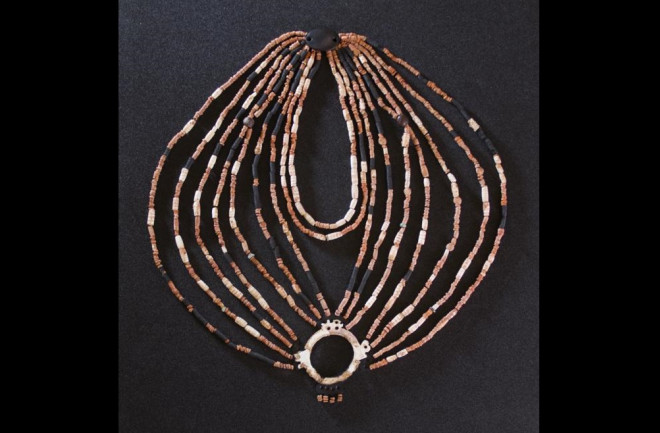Who was this girl, and why was her burial so special?
Those are the questions archaeologist Hala Alarashi and her colleagues ask in a new paper published in PLOSONE that details the burial of an 8-year-old girl in an ancient Jordanian town sometime between 7,400 and 6,800 B.C. Interred with her bones in the village of Ba‘ja, they found the piecemeal remains of some sort of intricate jewelry that had no precedent at this point in neolithic history.
“The making of the necklace appears to have involved meticulous work,” a statement says, “as well as the import of certain exotic materials from other regions.”
A Beaded Ancient Artifact
The team decided to reconstruct the ornamentation, which appeared to have been a necklace threaded with some string or “organic material” that had long ago decomposed.
They had much to work with: The team had collected and carefully recorded the positions of 2,500 colorful stone and shell beads, plus a large stone pendant and a badly damaged mother-of-pearl ring. Most had come to rest in the area of the child’s chest and neck, while the pendant had fallen behind the neck.
The ancient grave had presented quite a sight, as the remaining bones were stained red, either from decomposed clothes or dye the living had applied to the girl’s skin. To deal with time constraints, the team shipped the whole assemblage back to Europe and set about the painstaking task of reconstructing the ancient necklace.
After further mathematical analysis, the researchers came up with a 16-strand design that placed the pendant at the top of the design (reflecting where it had fallen) and the pale ring at the bottom.
“This necklace has no parallel in any of the Neolithic Levantine traditions known thus far,” the paper says. “The large volume, complex organization, symmetry, harmony, beauty of objects, play of lights and colors are in fact reminiscent of the refined ornaments of the latter urban Mesopotamian and Egyptian societies.”
A Community Gathering
Genetic analysis failed to provide more information about the child or her diet, or anything to explain her opulent burial.
She must have held “significant social status,” the paper says, while the occasion of burial would have been “a public event gathering families, relatives and people from other villages.”
The necklace is now part of the permanent collection at the Petra Museum in southern Jordan, where it’s on display.
In 2016, researchers found another elaborate grave in Ba‘ja belonging to a 16-year-old child, in a configuration that resembled that of the 8-year-old girl. And elsewhere in the settlement, archaeologists have uncovered a significant number of infants interred under house floors in the farming settlement, a relatively privileged place to be buried.
Read More: The 6 Most Iconic Artifacts From The Ancient World

